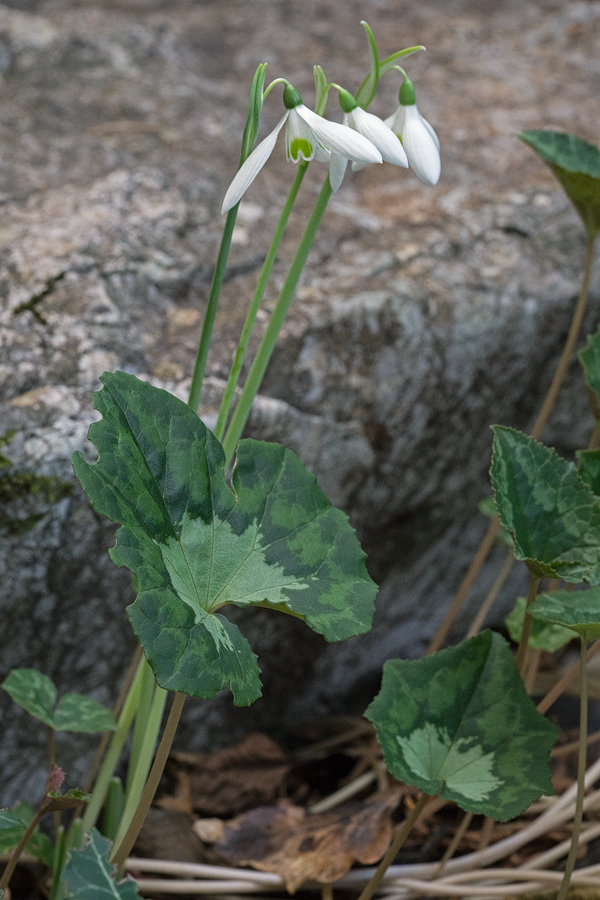
This is the first in what I hope will be a long series of blog posts describing the natural history of the snowdrop species that I succeed in finding on the snowdropathon, which is now into its third week. While the posts in this section of the blog are primarily aimed at committed snowdrop enthusiasts (I use that term loosely), I hope to recruit at least a few new followers to the cause. I will therefore try to tread an uneasy middle-ground between blithely using jargon that will mystify anyone not already steeped in Galanthus lore and irritating old hands, by patronisingly spelling out the meanings of familiar terms.
What I’m doing isn’t science and I’m not pretending it is. The evidence I adduce to support any conclusions I draw will be largely anecdotal and, as the classic social science credo goes, ‘anecdotes aren’t data’. That said, I am in the fortunate position of being able to gather an enormous number of anecdotes, in a relatively systematic fashion. I hope in the process to be able to assemble an informal natural history of the entire genus in the wild and add, however modestly, to our understanding of the diversity within and the relationships among the species of this small but wonderfully diverse group of plants.
Many groups of bulbs (more generally, ‘geophytes’, a slightly awkward term covering all perennial plants with an underground food-storage organ) contain members which flower in autumn, often on ‘naked’ stems, before any leaves have appeared, and others that flower in spring, often after snow melt or thaw. Crocus and Cyclamen are familiar examples of genera with spring and autumn flowering members.
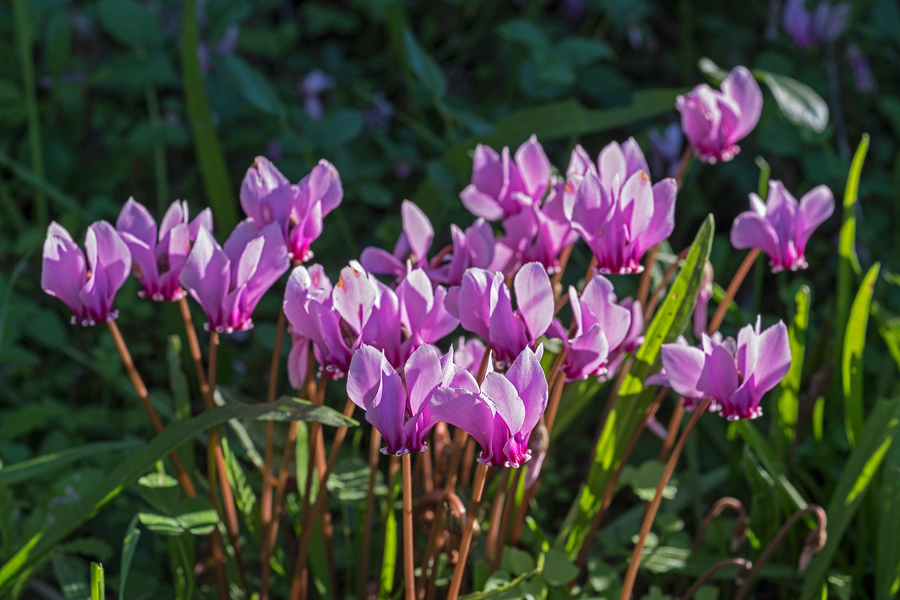

The only Galanthus species currently known to flower exclusively in autumn is G. peshmenii, which has a narrow ecological and geographic range in southern Turkey. Several other species, which occur over wider ranges, have populations that flower both before the onset of winter and in the spring. The more snowdrops are studied in the wild, the more autumn-flowering populations are discovered. To date, to my knowledge, autumn-flowering populations of G. elwesii, G. transcaucasicus, G. rizehensis and G. reginae-olgae have been found.
Galanthus reginae-olgae is the first to start flowering in the wild, as early as mid-October (and even earlier in cultivation in the UK). I spent a week on the Greek island of Corfu, between 22 and 29 October 2015, studying the variation in many populations, especially on and around the island’s highest peak, Pantokrator.
A kind friend had given me the names of three villages, near which he assured me I’d find snowdrops, if I looked carefully. And so it proved. In all three cases, the snowdrops were growing on steep slopes, facing between North and North-East, with tree cover in the form of olives or semi-natural woodland casting deep shade. Although the air was warm during the days (up to 27°C) and not a drop of rain fell during my stay, there had been heavy storms the previous week and the thin, stony soil, over limestone was damp, though the steep, rocky slopes drained water away quickly, so the soil was not saturated.
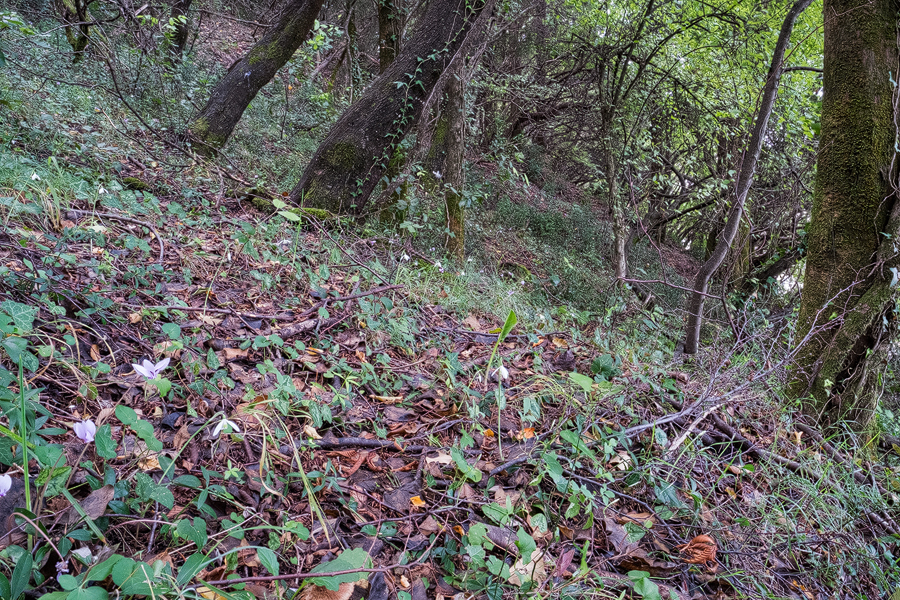
Having got an eye in for the right sort of habitat it was easy, though laborious, to find additional populations and, in the end, I found 25 populations, varying in size from a few plants to a few thousand plants. In every case the populations grew on slopes that faced between North and a few points East of North-East. If the slope swung just a few degrees beyond this arc, the snowdrops stopped.
In almost every case, the slope was also sufficiently steep that, at its zenith, the sun was not high enough in the sky to throw direct light on the forest floor, where the snowdrops were flowering. The only exceptions were plants at the edge of a population near the summit of Pantokrator. Even here, most of the population congregated at the bases of huge, weathered, limestone crags, which shaded the snowdrops from direct sunlight.

Most populations, except those near the summit of Pantokrator, occurred close to seasonal streams, most of which had virtually no water in them at this season. The streams had carved deep channels through the limestone and snowdrops appeared not to grow on the almost sheer banks of the channel, which is presumably frequently inundated. They did occur, however, on the lower part of the slopes immediately above the channels.
Again except at the summit of Pantokrator, the slopes on which snowdrops grew always had tree cover. A favoured habitat appeared to be mature olive groves and, in these places, snowdrops sometimes grew on flat, narrow terraces cut by olive farmers into the steep slopes and separated with retaining limestone walls. Other populations grew on abandoned terraces, which had been reclaimed by a mixture of native vegetation and old sweet chestnut trees. A few populations grew in what appeared to be natural or at least old secondary oak woodland, with a smattering of other deciduous and some evergreen trees. Near the summit of Pantokrator, snowdrops grew in rank grass, among bracken and other ferns and under conifers, typically in the shade of the aforementioned crags.

In places fitting this rather restrictive set of criteria – steep, facing between N and NE, close to seasonal streams, with closed canopy tree cover or full shade from overhanging boulders – snowdrops were by no means ubiquitous but were frequent enough that searches of promising sites were often rewarded.
The ground-level vegetation varied from site-to-site and, in olive groves, had often been cleared by farmers, either in the current or previous season. Cyclamen hederifolium was ubiquitous wherever Galanthus occurred and is indeed abundant in most habitats at all elevations on Corfu. Ivy and Butcher’s Broom, Ruscus aculeatus were also frequently associated with snowdrops, which often grew through a green carpet of ivy, among which the foliage of the Cyclamen was perfectly camouflaged, presumably an adaptation to confuse foraging pigs, not human botanists.
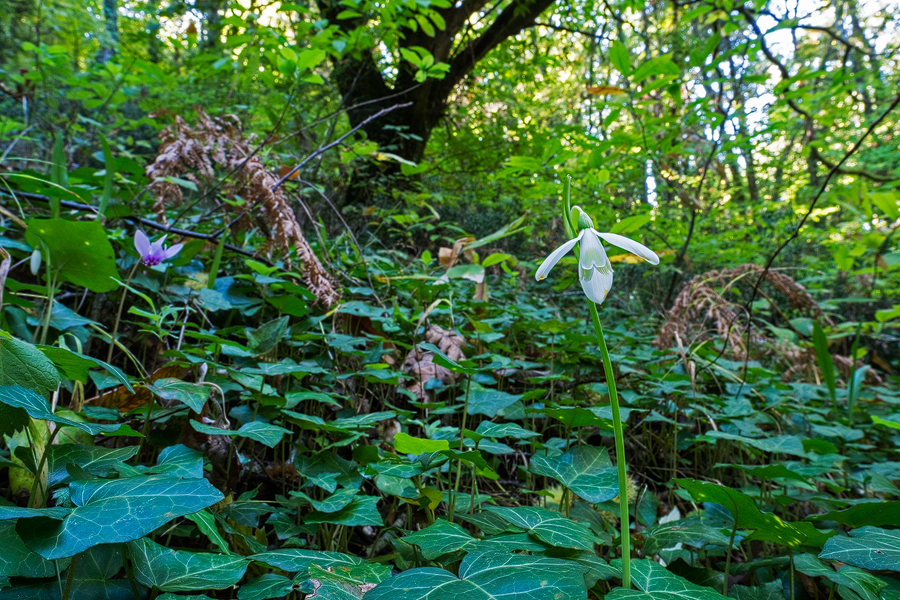
The great student of Galanthus in Greece, Georgia Kamari, reported that Galanthus on Corfu occurs only between 50m and 200m above sea level(1). This is clearly not true. I found snowdrops at every elevation from 50m, on the coast road south of Kassiopi, to 850m, just a short distance from the summit of the island’s highest peak.
Interestingly enough, the populations at higher elevations were more advanced in flowering than those lower down. Whereas the plants near the summit of Pantokrator were in full flower, a large majority of scapes at the lowest elevation sites in the NE of the island were barely emerging and perhaps two weeks from flowering. Presumably the colder nights and, perhaps, higher precipitation at the high elevation sites triggered these populations into flower earlier.
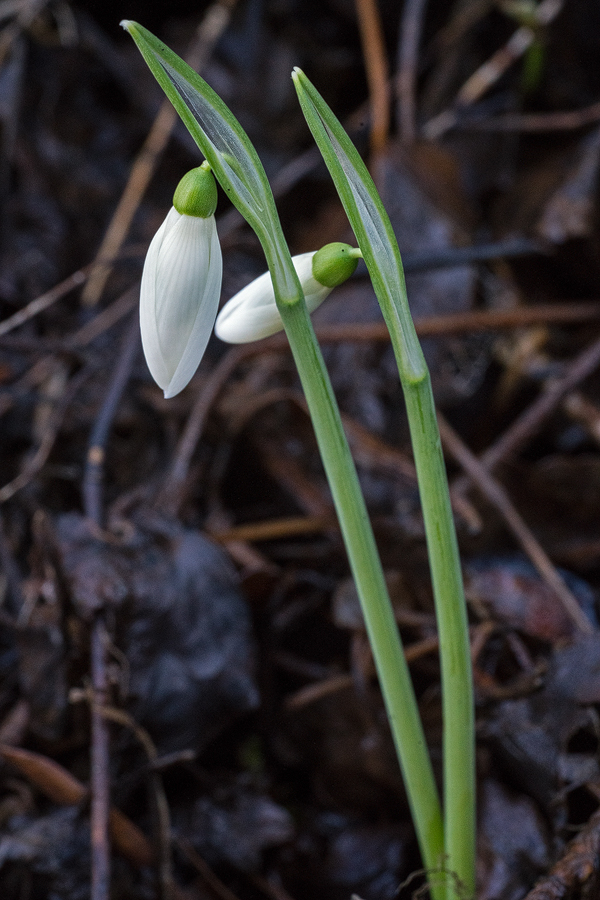
The snowdrops that occur on Corfu have been treated by some botanists as belonging to a separate species, G. corcyrensis, but Aaron Davies(2) reduced this name to a synonymof G. reginae-olgae (in a botanical context, that is to say Davies regards the name ‘corcyrensis‘ to be redundant, because it refers to the same species concept as the previously published name ‘reginae-olgae‘), a verdict which is now widely accepted, including by me. It seems to me the most reasonable treatment, especially given recent discoveries in Albania of populations of snowdrops biogeographically linking those in Corfu with other populations further north in the Balkans(3).
The currently accepted taxonomic treatment of Galanthus reginae-olgae divides it into two subspecies, subsp. reginae-olgae, which flowers in autumn before the leaves appear and subsp. vernalis, which flowers in spring with the leaves partially or almost fully emerged at flowering time. I contend that this distinction is entirely artificial and based in insufficient knowledge of wild populations, which can be found in flower at all dates between mid October and early April, with leaves at all stages of development from absent to fully emerged at flowering time. More on this theme as the season unfolds.
Morphologically, the snowdrops I saw in flower on Corfu this October were highly variable in all the features that attract the attention of galanthophiles, but which have tended to be neglected by botanists as somehow beneath their notice.
The leaves on most flowering plants were either absent or protruded a centimetre or two (perhaps 5cm at the most – next trip, I’ll bring a ruler) above the surface of the ground. In the latter cases, a characteristic glaucous stripe down the middle of the upper surface of the otherwise dark green leaf was already clearly visible.
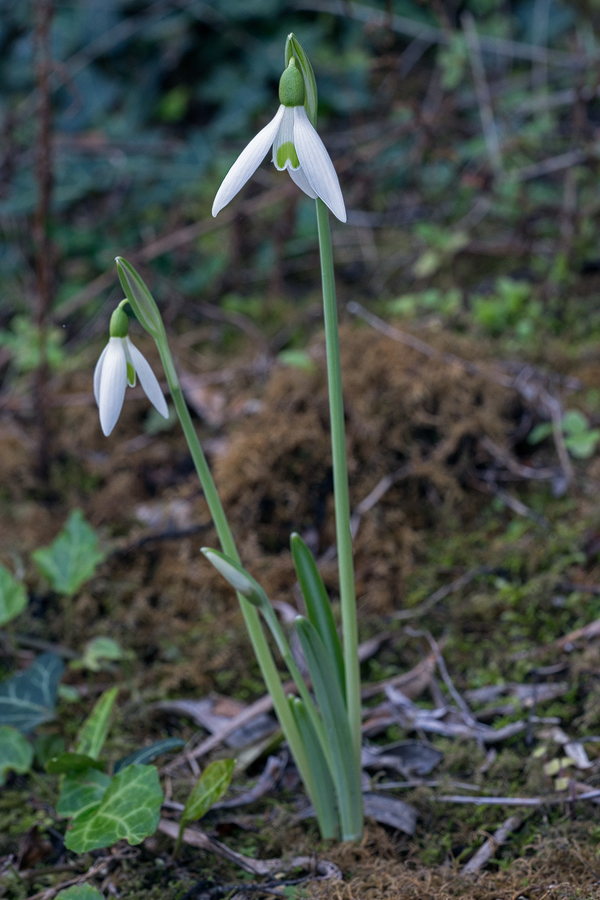
The scapes (flower stalks) varied enormously in length, from as little as 10cm to 30cm, on plants with apparently mature flowers. It was difficult to tell, however, whether the scapes on the shorter plants had completed their growth. I formed the impression that the tallest plants occurred in the deepest shade and scape length is possibly a response to light availability as well as genetic variability.
Many of the most robust plants produced two scapes per bulb, the first always considerably more advanced than the second.
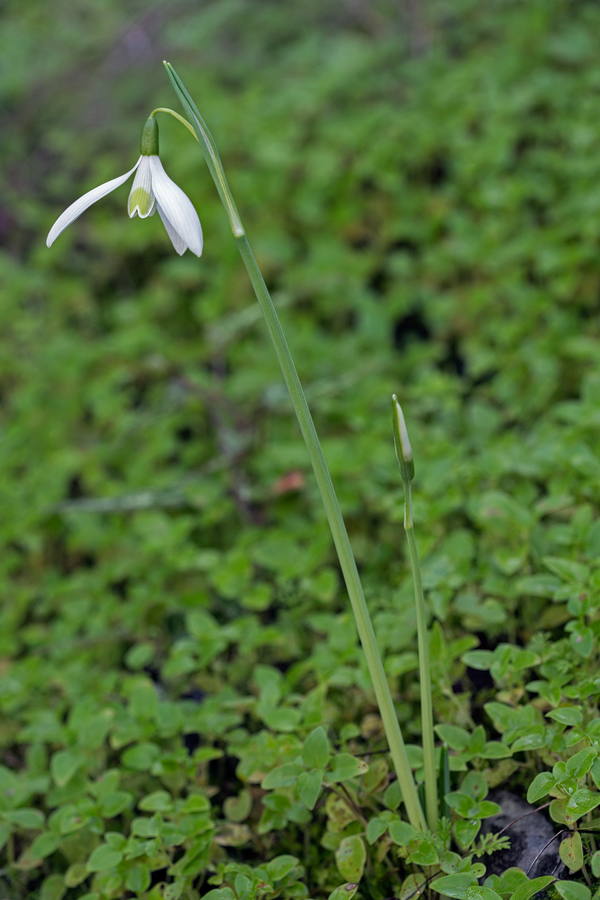
One could adequately describe the flowers as follows. Six perianth segments (petals to anyone who isn’t a pedant, as I am), in two whorls of three. The outer segments, about 2cm long and shaped like the keel of a boat, are about twice the length of the inner segments, which are flat, slightly flared at the apex. The inner segments have a small, V-shaped sinus (notch) at the apex and a green, more-or-less U-shaped mark above the sinus, covering less than a third of the segment on its adaxial (outside) surface, but often green to the base on the abaxial (inner) surface.
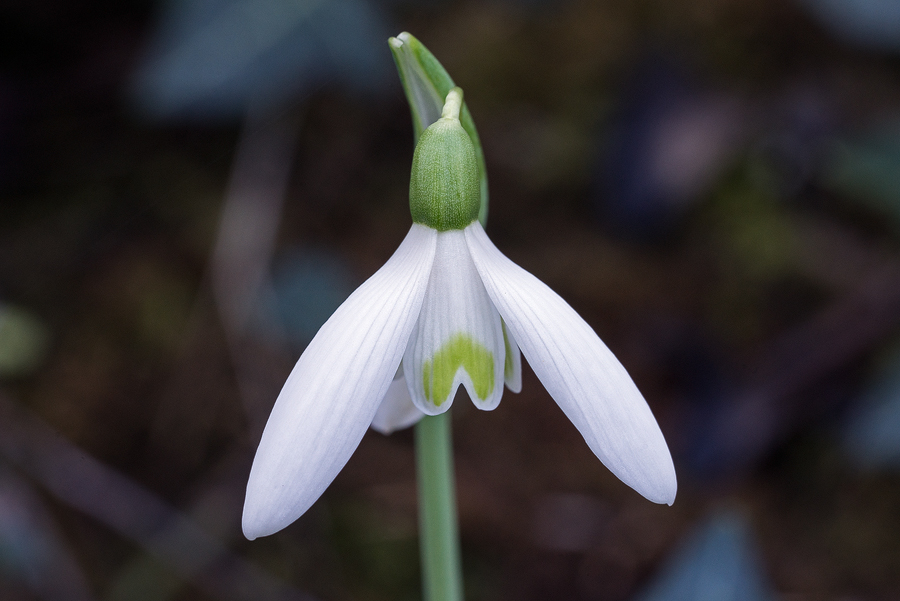
But this is where the fun, for a galanthophile, starts. For the flowers were hugely variable.
There were:
short ones,
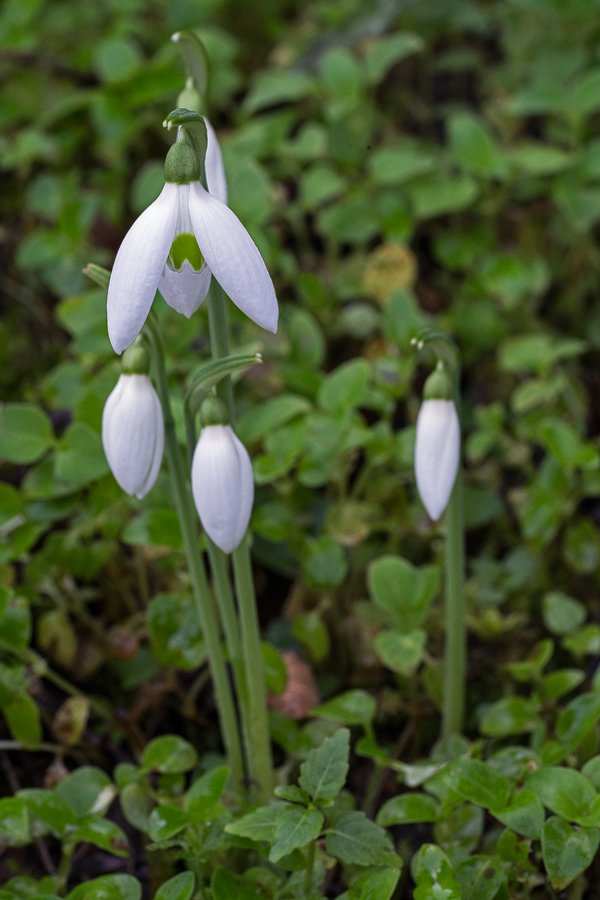
tall ones,
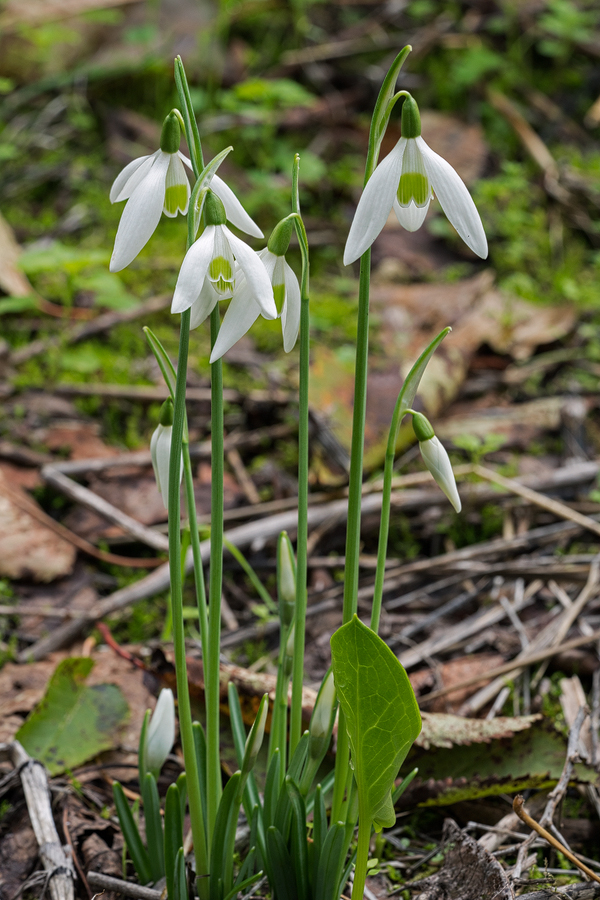
thin ones,
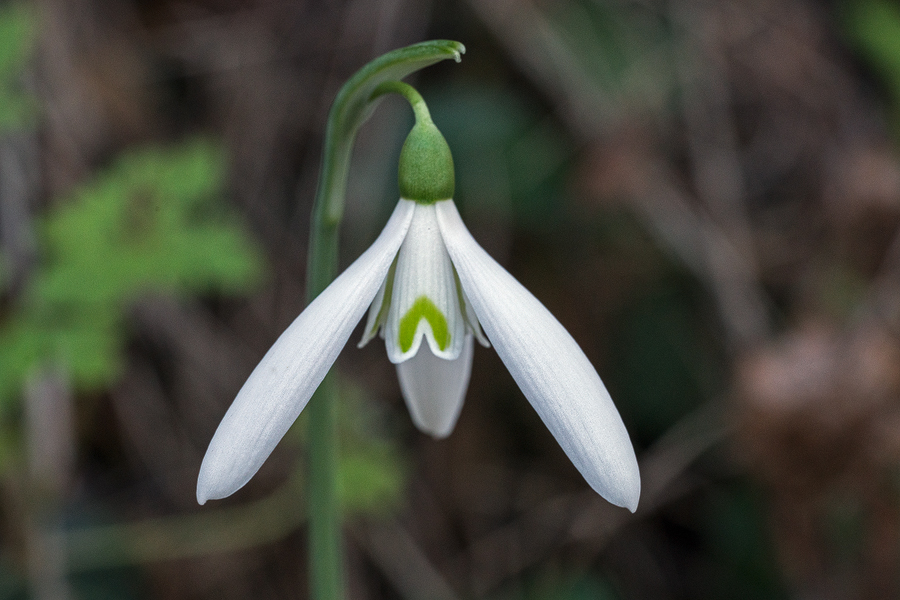
fat ones,
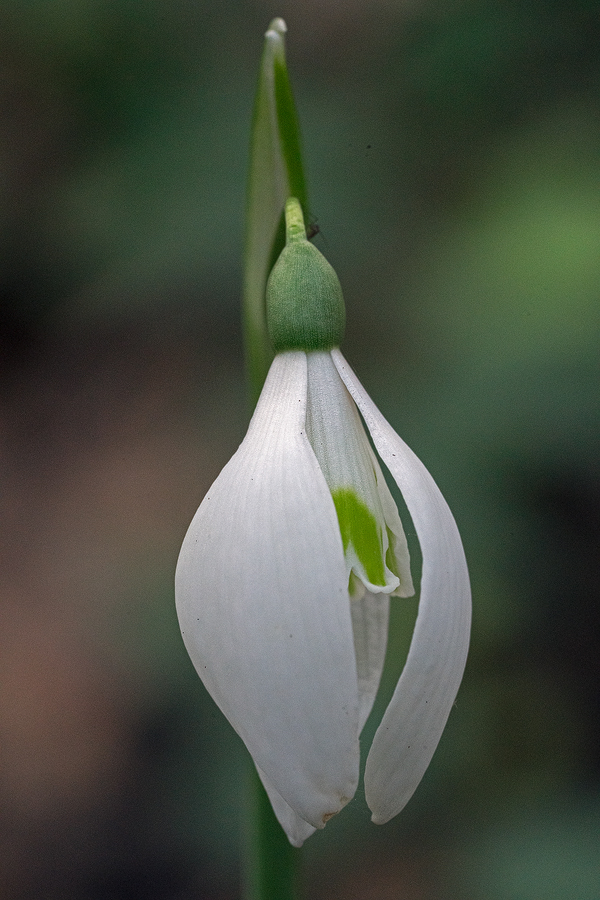
elegant ones,
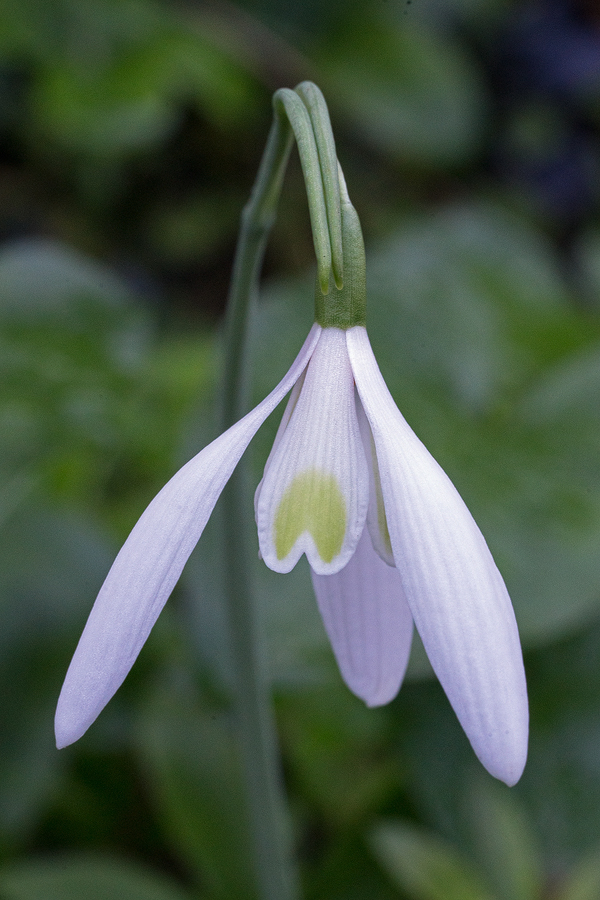
dumpy ones.
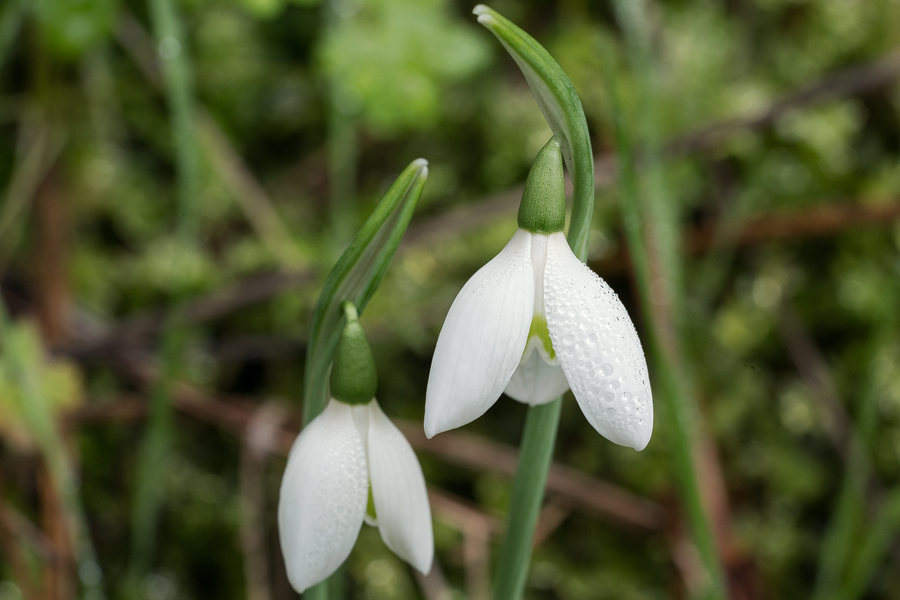
There were ones with only a U-shaped smudge of green at the tips of the inner segments.

Others had the inners stained completely green, like a set of incisor teeth carved from emeralds.
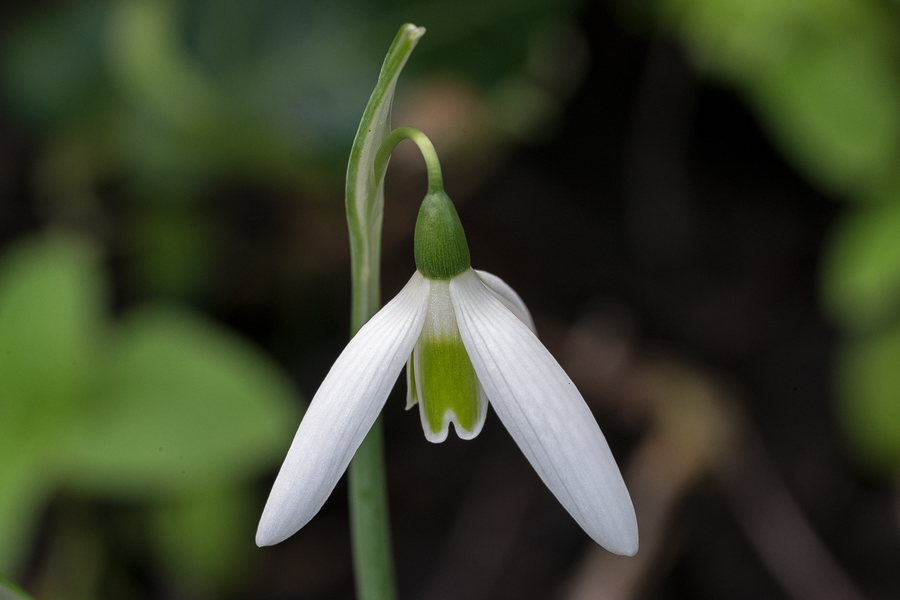
In most cases, the apical mark on the inner segments was a delicious pale chartreuse, and noticeably paler than the mid-green ovary. In some cases the mark was so pale it appeared almost yellow.
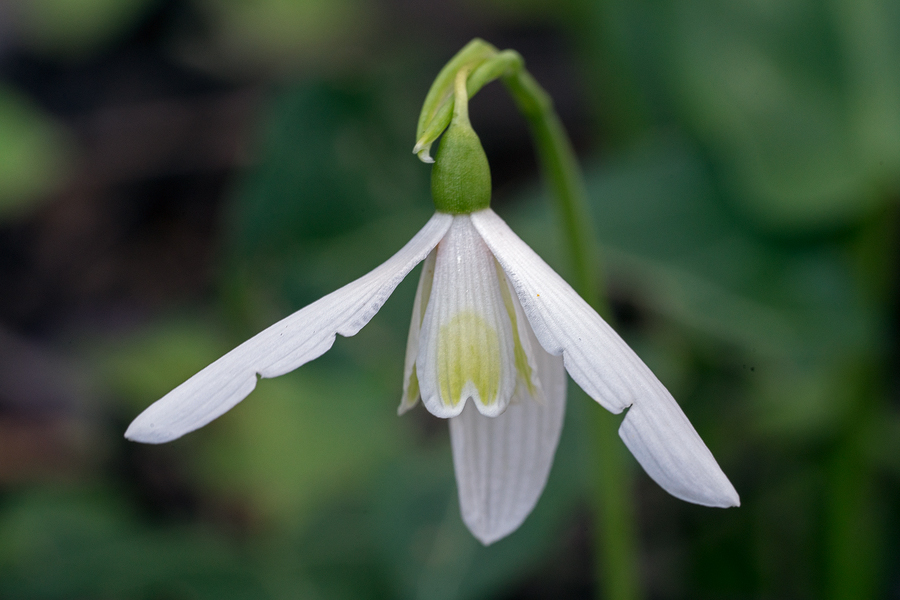
A miniscule fraction of plants had green smudges on the outer perianth segments too.
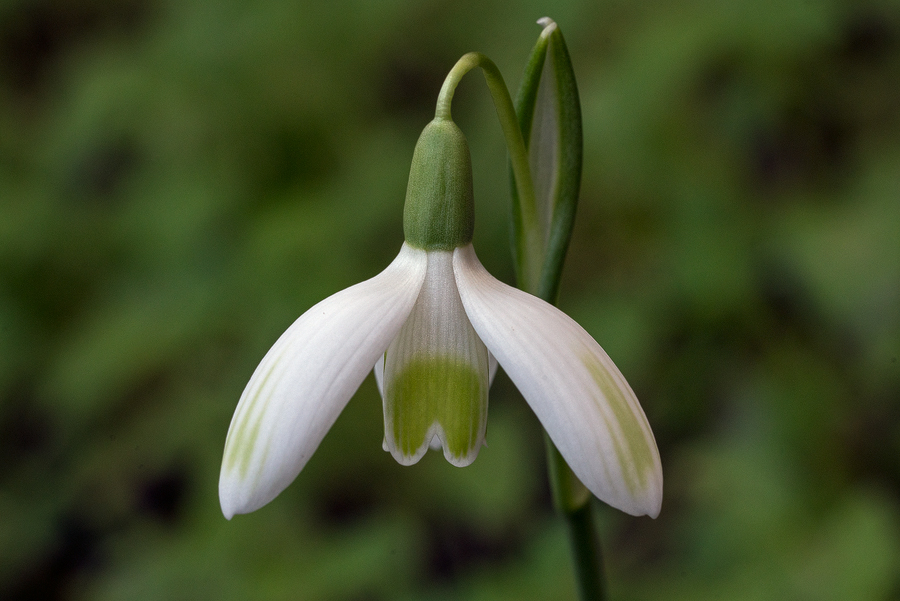
Typically, the inner segments were ‘flat’ at the apex but, in some cases, were pronouncedly flared.
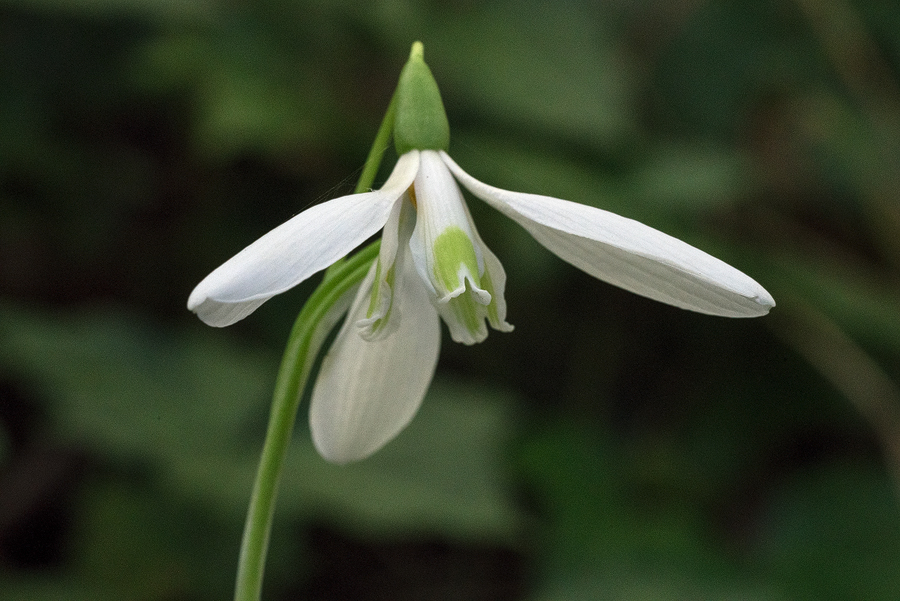
It is necessary, I’m afraid, to introduce here another bit of jargon. The ‘claw’ of a perianth segment (aka petal, remember) is the unhelpfully-named section at the base of the petal that joins the receptacle (the green, conical structure at the top of the scape) to the main part of the segment. The most elegant flowers had elongated claws, with the main part of the segment shaped like the keel of a rowing boat. The entire segment thus resembled one of the spoons that you are given in Japanese restaurants with your noodle soup. In some plants the claw represented perhaps a third of the flower’s length, whereas in others, less beautiful to my eyes, it was almost absent.
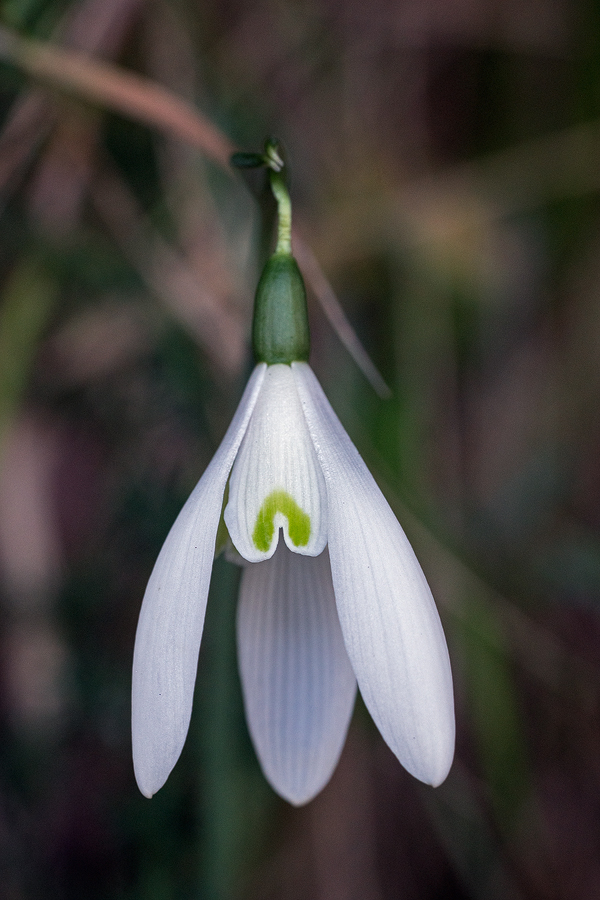
Most plants that I saw occurred as singletons – a single bulb that had not (yet) bulked up vegetatively into a clump. Occasionally clonal groups of three or four were to be seen. Rarely, in favoured positions, I saw big clumps. The most sublime snowdrops have an almost ineffable combination of qualities: habit, poise, vigour, symmetry, distinctiveness and purity that together combine to create an impression that evokes something special in that emotion in humans which responds to natural beauty with a drawing in of breath. The very last snowdrop colony I visited on Corfu boasted one such clump of plants.
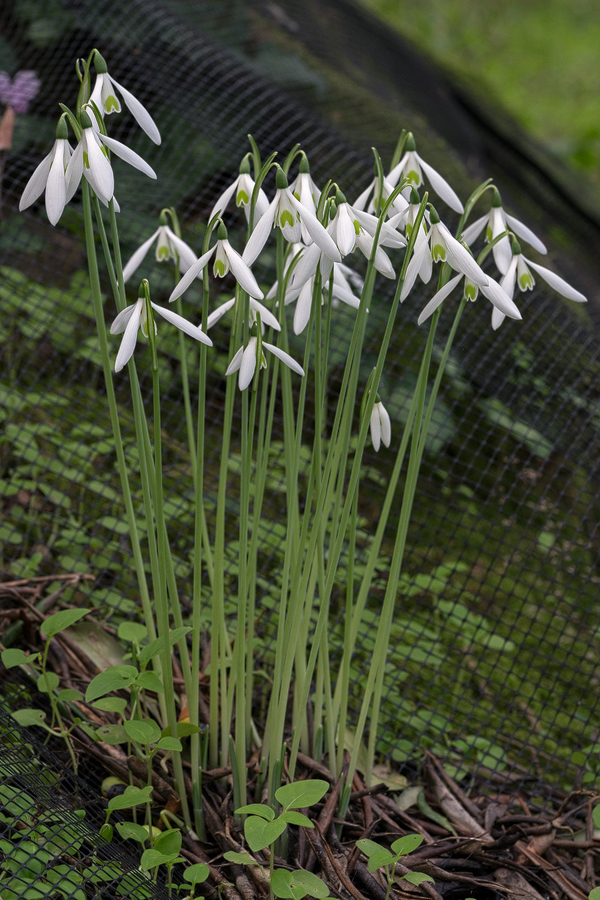
(1) Kamari, G. (1982): A biosystematic study of the genus Galanthus (Amaryllidaceae) in Greece. Bot. Jahrb. Syst. 103:113.
(2) Davis, Aaron (1999). The Genus Galanthus. A Botanical Magazine monograph. Portland, Oregon: Timber Press.
(3) Malo, Sadik & Shuka, Lulëzim (2008). New records on the flora of the Gjirokastra Region (South Albania). Natura Montenegrina 7(3): 369-373
